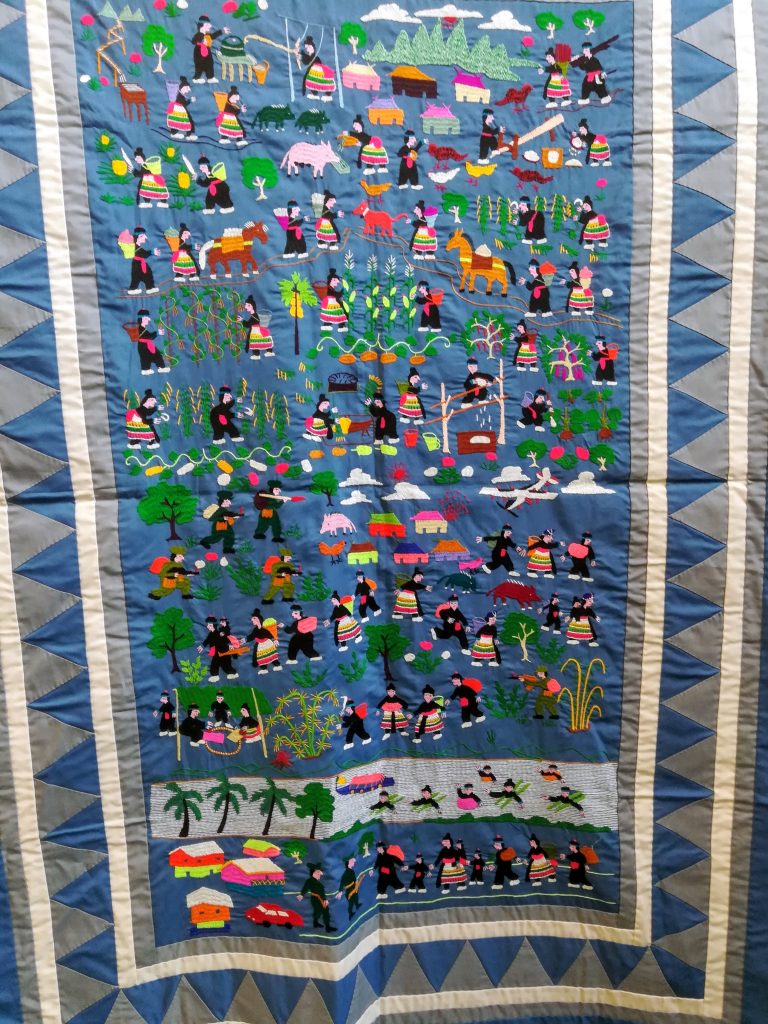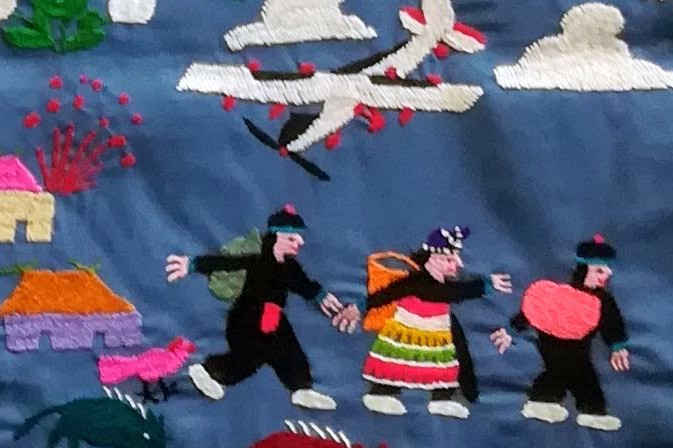 This Hmong story cloth, with accession number 2002.12.5.433, is about five feet tall and made from what appears to be some sort of colored yarn. It depicts a rural Hmong village in Laos where people are working peacefully until they are attacked in the context of the Laotian Civil War and forced to become refugees. There is nothing on this story cloth to indicate its creator or when it was made, whether during or after the events it depicts. They have traditionally been made by women for the purpose of storytelling within Hmong communities, which would make their intended audience Hmong.
This Hmong story cloth, with accession number 2002.12.5.433, is about five feet tall and made from what appears to be some sort of colored yarn. It depicts a rural Hmong village in Laos where people are working peacefully until they are attacked in the context of the Laotian Civil War and forced to become refugees. There is nothing on this story cloth to indicate its creator or when it was made, whether during or after the events it depicts. They have traditionally been made by women for the purpose of storytelling within Hmong communities, which would make their intended audience Hmong.
Some of the other story cloths portray the same overall narratives of fleeing due to the violence of the civil war, although they show different means of doing so. For example, while this one depicts refugees travelling mainly by foot, and apparently facing many natural and human obstacles along the way, others show people going by boat or by plane. Many show the refugees crossing a river (likely the Mekong) at the end and escaping the country (presumably into Thailand) where they are met by soldiers ready to take them to camps. The extent of the violence depicted varies. This one has planes bombing the village early on before soldiers attacking. One dramatic and extensive one shows fighting between opposing soldiers in the war, with one side, dressed the same as the villagers, huddled in trenches while fighter planes fly overhead and artillery shells them. Another has soldiers slaughtering civilians and setting dogs on them as they flee. Others do not have any of this violence, and simply show the people fleeing after all the violence. However, there are some story cloths that have a theme completely different from the refugees. For example, a few of them tell folktales, with anthropomorphic animals or plants.
There are some features common to all the story cloths. They all have a border with the same pattern but in different colors. Apparently different colors signify what dialect of the heterogeneous Hmong language the creator speaks. Different story cloths also have very similar art styles. It is not clear whether this is because all story cloths have this style or because all these story cloths were made by the same creator, but many of them seem to have used some universal templates for some of the objects they show, most noticeably people.
They also all have some sort of chronological storyline as you read from top to bottom and from right to left. This seems to be their defining characteristic. In this way they are in some ways comparable to the Lakota winter counts we looked at in class, although unlike the winter counts they are focused on people more than on events. The refugee story cloths especially are also distinguished from some of the other traditional ways of telling history, for example sagas or griots, in that they are less of a heroic narrative and more a chronological telling of events, uninfluenced by fate or deities and are not necessarily intended to encourage any sort of “right” behavior or actions. As far as the story cloth portrays (whether or not this reflects beliefs or realities), the people working in the villages at the beginning of some of the cloths have their own agency, autonomous from any higher powers, going about their daily chores and activities, until the war reaches them. This may not be as true of the story cloths telling folktales, but that more reflects the nature of the stories themselves than it does the nature of the medium used to tell them.

You must be logged in to post a comment.